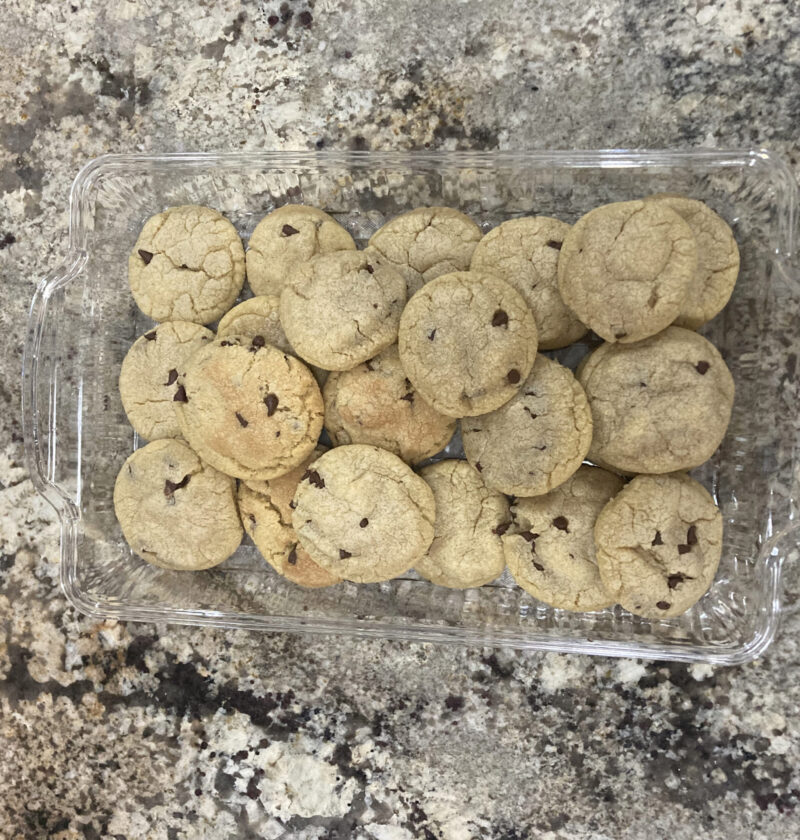
Chocolate chip cookies: it may be the most basic recipe, but it’s a favorite for a reason. I’ve always made my cookies the same way; I learned from my mother, my mother from hers, and probably generations before that, too. But now that I know about the science behind the chocolate chip cookie, I can get creative and tweak the ingredients and the way I bake them to make the perfect cookie for my liking! Follow along with me to see the ins and outs of America’s favorite recipe (did you know that it was created in the 1930s by Ruth Wakefield, who ran the famous Toll House restaurant in Massachusetts? The chocolate chip cookie is only 90 years old!) After reading this, hopefully you’ll have a new perspective when baking!
Ultimate Chocolate Chip Cookies Recipe – BettyCrocker.com
Science Behind the Chocolate Chip Cookie:
To start, let’s talk about the role of each ingredient step by step.
Heat oven to 375 degrees F.
The recipe for chocolate chip cookies that we found is fairly straightforward and is not comprised of many ingredients. That said, each ingredient and step is an important part of the overall process that lends to creating what we found to be a great traditional cookie recipe. The recipe begins by calling for an oven to be set to 375 degrees Fahrenheit. This is done before all of the other steps, so that the oven has time to reach the proper temperature before the cookie dough is put in to begin baking (Budzaki, Daliborka, Kenjeric & Kozul 2014).
In a small bowl, mix flour, baking soda and salt; set aside.
Flour is a structure-building ingredient that stabilizes the entire mixture and helps to control how much the cookies rise (Schloss & Joachim 2018). The flour added can be tampered with to create a cookie that is crispy, chewy, or crumbly, depending on preference. In this recipe, 2 ¼ cups of all-purpose flour is added to the mixture in the bowl. This amount was ideal, as it was enough to lend shape to the cookie but not too much that it rendered the entire cookie thick or bland. Baking soda was also added to the initial mixture, which is a leavening agent. Through this addition, air pockets already present in the dough are increased when the dough is heated, because baking soda reacts with either acidic compounds or heat to form carbon dioxide gas (Schloss & Joachim 2018). In this instance, the addition of baking soda helps to create a light, airy cookie that still has structure but is not super heavy (Newshouse & Burgoyne 2012). Finally, the salt added to the mixture acts as a flavor enhancer. It is also an additional structure-building ingredient, but much less salt is added than flour so the purpose here is primarily for flavor.
In a large bowl, beat softened butter and sugars with an electric mixer on medium speed, or mix with spoon about 1 minute or until fluffy, scraping side of bowl occasionally.
The role of butter is to give flavor and control gluten development, as it has fat and moisture. It incorporates air into the cookie dough when mixed with sugar, which helps the cookie rise (Lopez-Alt 2020). When flour is mixed with water (like the water found in eggs), it develops gluten, interconnected proteins that set up as they bake. To keep the cookies tender, our recipe suggests using softened butter. This semi-soft form of butter helps the fat coat proteins in the cookie dough, preventing gluten development, which makes a cookie finer rather than chewy (Lopez-Alt 2020). If chewy is more your style, try melted butter–it mixes readily with sugar and flour and develops more gluten because of the moisture. The recipe says to beat the softened butter and sugars with a mixer or spoon until it is fluffy. Butter is an emulsion of fat and water, and sugar is hydrophilic, meaning it is attracted to water. If you’re looking for a nuttier, toasted flavor, you can brown the butter and then mix it (Newshouse & Burgoyne 2012).
Our recipe calls for the same amount of granulated sugar as brown sugar, ¾ cups. During baking, most recipes call for more than what actually dissolves during mixing. Granulated white sugar is crystallized sucrose with a neutral PH, whereas brown sugar is crystallized sucrose with a good amount of glucose and fructose (Lopez-Alt). It contains molasses, which is slightly acidic, and therefore makes cookies more moist and chewier (Schloss & Joachim). Granulated white sugar makes cookies browner through caramelization, and crisper by absorbing moisture in the dough (Schloss & Joachim). A mixture of the two provides a good balance, but if you want the chewiest, most uniformly textured cookies, try replacing some of the granulated sugar with corn syrup, which is made up of simple sugars (Lopez-Alt).
Beat in egg and vanilla until smooth. Stir in flour mixture just until blended (dough will be stiff).
The third step of the recipe is to beat an egg and 1 tsp vanilla into the mixture. The purpose of the egg is to lend structure to the dough, along with the flour. The egg helps give the dough some shape, so the cookies do not immediately flatten out while baking. A source of protein and moisture come from the eggs, which bond with the starch and protein in flour. Because egg yolk is a natural emulsifier, it makes the cookie batter smooth and creamy (Schloss & Joachim). This is where the structure-building properties come in, as the strong bonds help hold the cookie together and lend to the traditional shape. The 1 tsp of vanilla has an important purpose as well. Vanilla strengthens the sweetness of other flavors in the recipe. When the flour mixture is added, the dough comes together.
Stir in chocolate chips.
“Chocolate bloom” happens when chocolate is not tempered properly. It sometimes happens when you leave chocolate in your car on a hot day, when the temperature rises, the chocolate melts, and then cools. When it comes to chocolate chip cookies, it’s all about the location of the chip in the cookie. If it is embedded in a fat-containing baked good, it will not undergo bloom, but it will if the chip is on the edge or lightly on top (minimal dough contact) (Provost, Colabroy, Kelly, & Waller). When two fats are mixed, crystallization is different–milk fat from butter will prevent bloom (Provost, Colabroy, Kelly, & Waller). The recipe calls for semi-sweet chocolate chips, so we added those within our dough to avoid bloom. But, just to see if you notice the difference in texture, changing the placement and type of chocolate could be a fun experiment (because it does not affect taste!)
Onto ungreased cookie sheets, drop dough by rounded tablespoonfuls 2 inches apart.
Instead of jumping to this, we tried something different. Letting the cookie dough rest in the refrigerator for 24 to 36 hours is not in the recipe, but it makes a difference on texture and taste. This process would remove the air from the dough and evenly distribute moisture (Vega & Linden 2012). After that, to the oven it goes!
As you can see, there is a lot of science involved in making chocolate chip cookies. The fun part is even small tweaks to a recipe can lead to a different finished product. Below you will find the exact recipe, minus the science so you can follow along. Hopefully you’ll think about the science behind the chocolate chip cookie next time you go to bake them!
(photos by me)
Ingredients
Instructions
-
Heat oven to 375 degrees F. In a small bowl, mix flour, baking soda and salt; set aside.
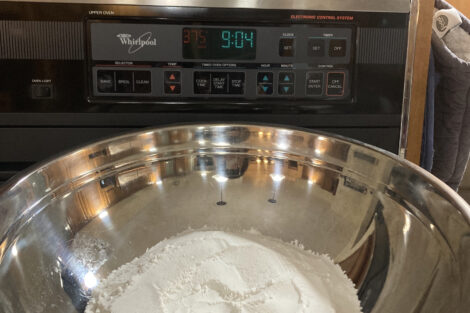
-
In a large bowl, beat softened butter and sugars with an electric mixer on medium speed, or mix with spoon about 1 minute or until fluffy, scraping side of bowl occasionally.
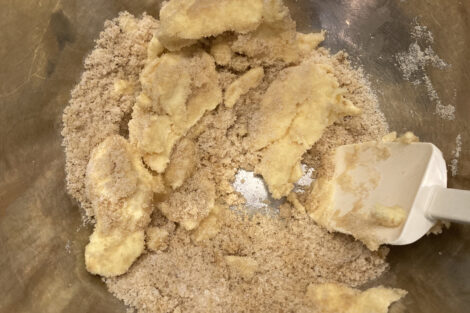
-
Beat in egg and vanilla until smooth. Stir in flour mixture just until blended (dough will be stiff). Stir in chocolate chips.
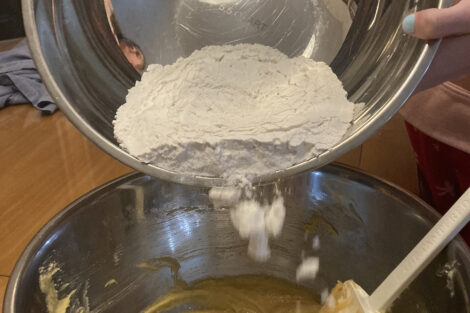
-
Onto ungreased cookie sheets, drop dough by rounded tablespoonfuls 2 inches apart.
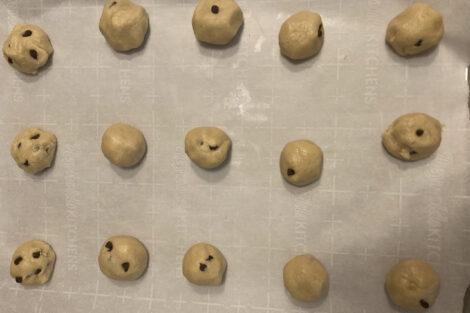
-
Bake 8 to 10 minutes or until light brown (centers will be soft). Cool 2 minutes; remove from cookie sheet to cooling rack. Cool completely, about 30 minutes. Store covered in airtight container.
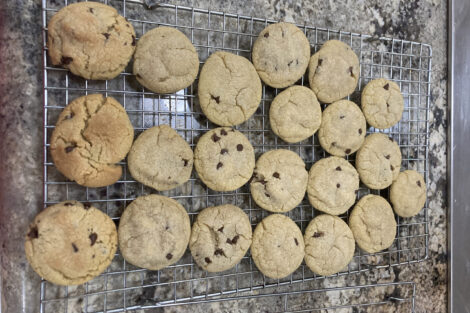
Notes
works cited:
Budžaki, Sandra & Komlenić, Daliborka & Čačić, Jasmina & Čačić Kenjerić, Frane & Jukić, M. & Kožul, Ž. (2014). Influence of cookies composition on temperature profiles and qualitative parameters during baking. Croatian Journal of Food Science and Technology. Croat. J. Food Science Technology. DOI:10.17508/CJFST.2014.6.2.02
Crosby, Newhouse, M., & Burgoyne, J. (2012). The Science of Good Cooking: Master 50 simple concepts to enjoy a lifetime of success in the kitchen. America’s Test Kitchen.
Lopez-Alt, Kenji J. (2020, September 12). The Food Lab: The Science of the Best Chocolate Chip Cookies. Serious Eats. Retrieved April 18, 2022 from https://www.seriouseats.com/the-food-lab-best-chocolate-chip-cookie-recipe#toc-butter-affects-a-cookies-flavor-and-texture
Provost, Joseph J., Colabroy, Keri L., Kelly, Brenda S., and Waller, Mark A. (2016). The Science of Cooking: Understanding the Biology and Chemistry Behind Food and Cooking. Wiley.
Schloss, Andrew, Joachim, David. (2018). The Science of Baking Cookies. Fine Cooking Issue 126. Retrieved April 18, 2022 from https://www.finecooking.com/article/the-science-of-baking-cookies-2
Vega, Ubbink, J., & Linden, E. van der. (2012). The Kitchen as Laboratory: Reflections on the Science of Food and Cooking. Columbia University Press. DOI: 10.7312/vega15344